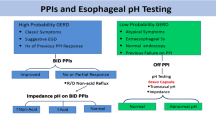Abstract
Twenty-four-hour esophageal pH monitoring is regarded as the gold standard investigation for gastroesophageal reflux (GER) (1) and the possibility of an “incorrect” answer, false positive or false negative, is only rarely considered (2). However, when a group of infants in this hospital had such pH studies performed on two consecutive days, considerable differences in the results were found (3). This also had been reported from other centers (4–6). It seems likely that most of the differences were due to true “biological” variability in the amount of GER from day to day, but it remains possible that variation in the accuracy of the equipment in detecting acid reflux was also involved.
Similar content being viewed by others
References
DeMeester TR, Johnson LF: The evaluation of objective measurements of gastroesophageal reflux and their contribution to patient management. Surg Clin North Am 56:39–53, 1976
Schlesinger PK, Donahue PE, Schmid B, Layden TJ: Limitations of 24-hour intraesophageal pH monitoring in the hospital setting. Gastroenterology 89:797–804, 1985
Hampton FJ, MacFadyen UM, Simpson H: Reproducibility of twenty-four hour esophageal pH studies in infants. Arch Dis Child 65:1249–1254, 1990
Weiner GJ, Morgan TM, Copper JB, Wu WC, Castell DO, Sinclair JW, Richter JE: Ambulatory 24-hour esophageal pH monitoring: reproducibility and variability of pH parameters. Dig Dis Sci 33:1127–1133, 1988
Johnsson F, Joelsson BO: Reproducibility of ambulatory esophageal pH monitoring. Gut 29:886–889, 1988
Vandenplas Y, Helven R, Goyvaerts H, Sacre L: Reproducibility of continuous 24 hour esophageal pH monitoring in infants and children. Gut 31:374–377, 1990
McLauchlan G, Rawlings JM, Lucas ML, McCloy RF, Crean GP, McColl KEL: Electrodes for 24 hour pH monitoring—a comparative study. Gut 28:935–939, 1987
Ask P, Edwall G, Johansson K-E: Accuracy and choice of procedures in 24-hour esophageal pH monitoring with monocrystalline antimony electrodes. Med Biol Eng Comput 24:602–608, 1986
Murphy DW, Yuan Y, Castell DO: Does the intraesophageal pH probe accurately detect acid reflux? Simultaneous recording with two probes in humans. Dig Dis Sci 34:649–656, 1989
Murphy DW, Faust KB, Chiantella VM, Castell DO: Assessment of accuracy of intraesophageal pH probe in a dog model. Dig Dis Sci 34:1079–1084, 1989
Herrera JL, Simpson JK, Maydonovitch CL, Wong RKH: Comparison of stationary vs ambulatory 24-hour pH monitoring recording systems. Dig Dis Sci 33:385–388, 1988
Ward BW, Wu WC, Richter JE, Lui KW, Castell DO: Ambulatory 24 hour esophageal pH monitoring. J Clin Gastroenterol 8(suppl 1):59–67, 1986
Author information
Authors and Affiliations
Rights and permissions
About this article
Cite this article
Hampton, F.J., MacFadyen, U.M. & Mayberry, J.F. Variations in results of simultaneous ambulatory esophageal pH monitoring. Digest Dis Sci 37, 506–512 (1992). https://doi.org/10.1007/BF01307571
Received:
Revised:
Accepted:
Issue Date:
DOI: https://doi.org/10.1007/BF01307571




